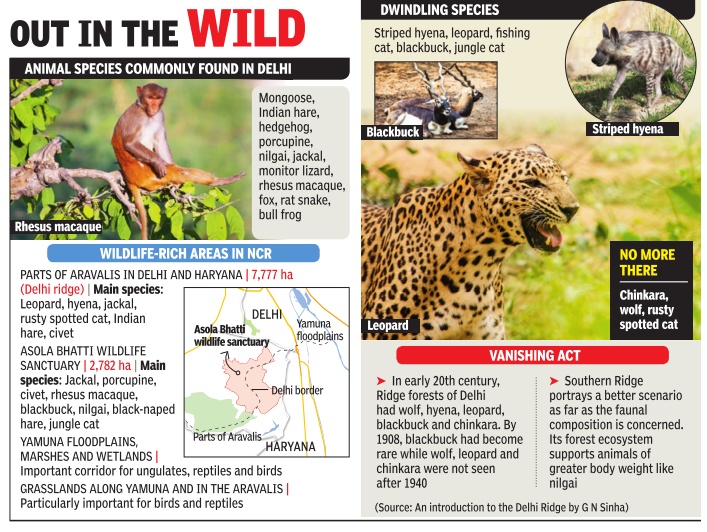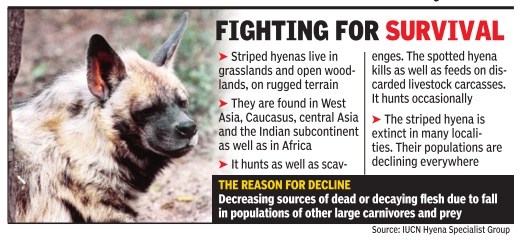Delhi: Wildlife (Fauna)

This is a collection of articles archived for the excellence of their content. |
Hyena
The Times of India, Jul 12 2015

Asola-Bhatti can be NCR's hyena habitat
Delhi's depleting scrub forests and the Aravalis around it may be home to the threatened striped hyena.While the forest department believes there may be a fairly healthy population, they will confirm it by camera trapping in a couple of months. Hyenas may not be as charismatic as the tiger or leopard but, if nurtured, Delhi's Asola Bhatti Sanctuary can be made to stand out as a habitat for the animal. The department had conducted a camera trapping exercise way back in 2000 and officials claim a pack was seen often in those days.
There is no dearth of prey or food for hyenas in the sanctuary . Experts say they can thrive on dead cattle, dead dogs or monkeys or even hunt for food. There is a dumping ground for dead animals near the Haryana border, too, which hyenas may be foraging on.
A book, “An Introduction to Delhi Ridge”, edited by G N Sinha, former additional principal chief conservator of forests, mentions “a pack of striped hyenas is also spotted occasionally in the Bhatti area“.
Asola Bhatti sanctuary is a small area of 4,707 acres in Maidan Garhi, notified in 1986, and about 2,167 acres in Bhatti, notified in 1991. But it shares a border with the Faridabad frontier of the Aravalis, making it an important wildlife corridor. The department is in talks with the Haryana government to secure an eco-sensitive zone shared between the two states.
Man-animal conflict
The Times of India, May 28, 2016
Jasjeev Gandhiok While dramatic sightings like a leopard in a PVR Saket mall in 2003 and a python slithering through another mall are not very common in Delhi, the nilgai that kept foresters and cops on their toes for nearly five hours at Vijay Chowk on Thursday shows that animals are straying from their habitat in search of food.
Forest officials say the Ridge, wetlands and other forest patches in NCR are drying up.“There isn't enough water or food for animals,“ said A K Shukla, chief wildlife warden. Officials pointed out that the walling of the Central Ridge and the segregation of other wild patches have severely restricted the movement of animals.
While wildlife islands were steadily created in the National Capital Region over the years, no effort was made to connect important corridors such as Mangar Bani in Haryana with the Asola Bhatti sanctuary or the Rajasthan Aravalis with the Haryana Aravalis. In other stretches, like the Yamuna banks, residential colonies came up. The result is a dwindling wildlife. Jungle cats haven't been seen in a long time, and while the forest department spotted pugmarks of striped hyenas recently , there were no direct sightings. Animal NGOs have reported a few leopard sightings and pugmarks in Asola Bhatti and around the Faridabad Aravalis. There may be very few blackbucks, porcupines, mongoose, nilgais and civet cats still extant.
There was talk of linking Mangar Bani with Asola by including these areas in the Haryana's eco-sensitive zone, but it remained just talk. There were also suggestions of making over-passes or under-passes for animals on the Gurgaon-Faridabad highway but nothing materialised.
“The Ridge is not a contiguous stretch, but a series of disjointed forests,“ explained Kartick Satyanarayan, co-founder of Wildlife SOS. “This means the animals cannot stay clustered in one area, and when they try to move around, the chances of their coming face to face with humans are high.“ Fencing work in these locations also disorients animals, which like Thursday's nilgai, then find it difficult to find their way back to their habitats.
Satyanarayan is clear that there is a need to sensitise people to man-animal conflicts because invariably crowds collect at a scene where an animal is sighted, aggravating the situation. He recollected that the leopard at the Saket mall was tranquillised but still had to be shot by the cops because there was panic among the people.
Wildlife SOS sees a huge jump in cases of conflict for the past five to seven years--majority of complaints are of snakes, monitor lizards, civet cats and birds like kites and owls.
According to Faiyaz Khudsar, scientist in-charge at the Yamuna Biodiversity Park, animals are increasingly trying to adapt to the concrete around them and to the massive crunch in food and water. This could be dangerous. “If an animal does not find enough food in the Ridge areas, it will naturally go elsewhere,“ said Khudsar. “So, seeing leopards or other animals in the city is not quite so unnatural.“
What little there is of wildlife in Delhi needs to be preserved. For this, among other steps suggested by experts, the Ridge will have to be treated as a “sanctum sanctorum“.